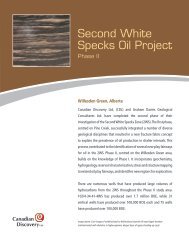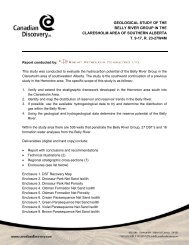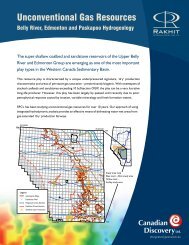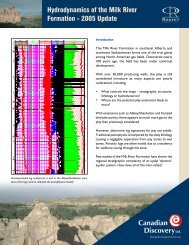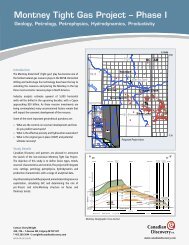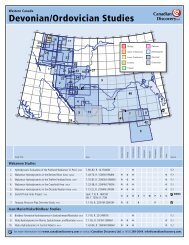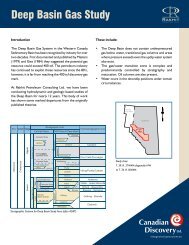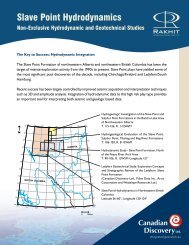exploration review THE BAKKEN AT ANTLER AND SINCLAIR
exploration review THE BAKKEN AT ANTLER AND SINCLAIR
exploration review THE BAKKEN AT ANTLER AND SINCLAIR
Create successful ePaper yourself
Turn your PDF publications into a flip-book with our unique Google optimized e-Paper software.
EXPLOR<strong>AT</strong>ION REVIEW<br />
<strong>BAKKEN</strong> MEMBERS SUBCROP - WILLISTON BASIN<br />
FROM WALKER, 2006<br />
because the oil was generated there, or because it migrated<br />
there from more mature source rocks in North Dakota that<br />
are well within the oil window. It is useful to think of the<br />
Bakken as a continuous system, from near the top of the<br />
Three Forks, to near the base of the Lodgepole Formation.<br />
This accounts for the fact that oil sourced in the Bakken is<br />
sometimes produced from these other zones, when suitable<br />
reservoir rock is in direct contact with the Bakken source<br />
rocks. Oil analyses suggests that this continuous system has<br />
lost very little of the oil it has generated. There has been little<br />
in the way of expulsion to other zones because of tighter<br />
rock below in the Devonian Three Forks Group and above<br />
in the Mississippian Lodgepole Formation of the Madison<br />
Group. (Price and LeFever, 1994)<br />
WEST<br />
EAST<br />
Elm Coulee Area<br />
Three Forks fm (Dev)<br />
Nesson Anticline<br />
Antelope Field<br />
Lodgepole fm (Miss)<br />
Three Forks fm (Dev)<br />
<strong>BAKKEN</strong> REGIONAL CROSS - SECTION - WILLISTON BASIN<br />
FROM WALKER, 2006<br />
B32 VOLUME 5 2006 CANADIAN DISCOVERY DIGEST<br />
Modified after Meissner (1978)






